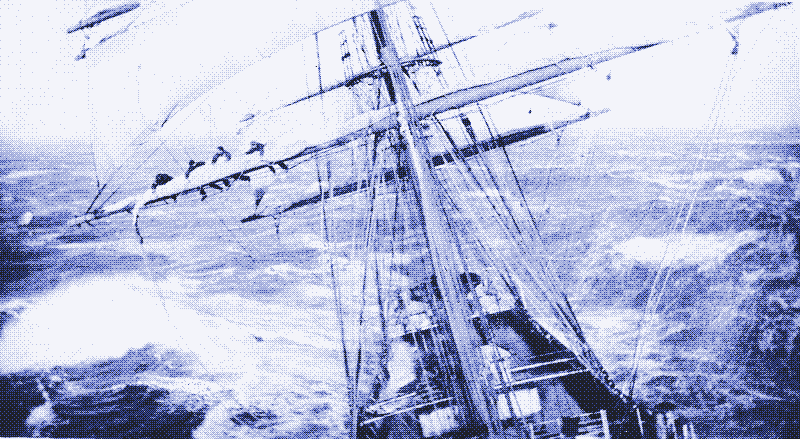
The sailing ship is a textbook example of sustainability. For at least 4,000 years, sailing ships have transported passengers and cargo across the world’s seas and oceans without using a single drop of fossil fuels. If we want to keep travelling and trading globally in a low carbon society, sailing ships are the obvious alternative to container ships, bulk carriers, and airplanes.
However, by definition, the sailing ship is not a carbon neutral technology. For most of history, sailing ships were built from wood, but back then whole forests were felled for ships, and those trees often did not grow back. In the late nineteenth and early twentieth century, sailing ships were increasingly made from steel, which also has a significant carbon footprint.
The carbon neutrality of sailing in the 21st century is even more elusive. That’s because we have changed profoundly since the Age of Sail. Compared to our forebears, we have higher demands in terms of safety, comfort, convenience, and cleanliness. These higher standards are difficult to achieve unless the ship also has a diesel engine and generator on-board.
The revival of the sailing ship
The sailing ship has seen a modest revival in the last decade, especially for the transportation of cargo. In 2009, Dutch company Fairtransport started shipping freight between Europe and the Americas with the Tres Hombres, a sailing ship built in 1943. The company remains active today and has a second ship in service since 2015, the Nordlys (built in 1873).
Since then, others have joined the sail cargo business. In 2016, the German company Timbercoast started shipping cargo with the Avontuur, a ship built in 1920. 1 In 2017, the French Blue Schooner Company started transporting cargo between Europe and the Americas with the Gallant, a sailing ship that was built in 1916. 2 All these sailing ships were constructed in the twentieth or nineteenth century, and were restored at a later date. However, a revival of sail cannot rely on historical ships alone, because there’s not enough of them. 3
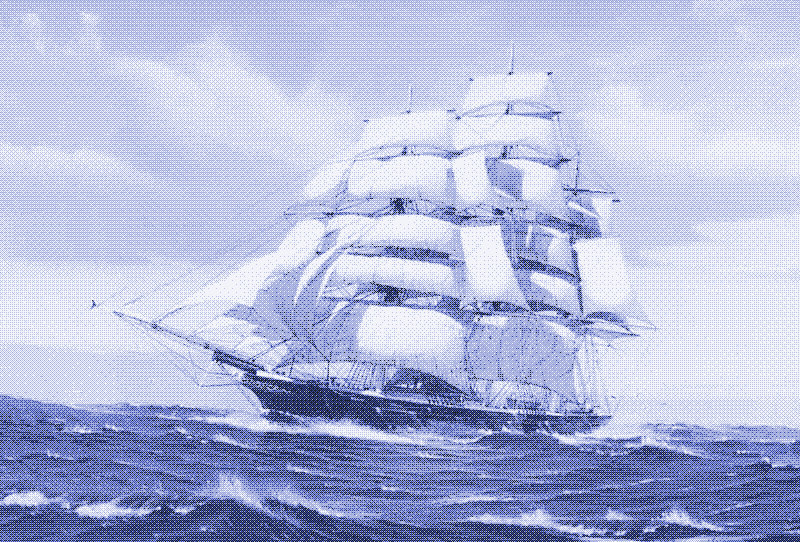
At the moment, there are at least two sailing ships in development that are being built from scratch: the Ceiba and the EcoClipper500. The first ship is being constructed in Costa Rica by a company named Sailcargo. She is built from wood and inspired by a Finnish ship from the twentieth century. The second ship is designed by a company called EcoClipper, which is led by one of the founders of the Dutch FairTransport, Jorne Langelaan. Their EcoClipper500 is a steel replica of a Dutch clipper ship from 1857: the Noach.
“Old designs are not necessarily the best", says Jorne Langelaan, “but whenever proven design is used, one can be sure of its performance. A new design is more of a gamble. Furthermore, in the 20th and 21st century, sailing technology developed for fast sailing yachts, which is an entirely different story compared to ships which need to be able to carry cargo.”
More economical sailing ships
These two ships – one under construction and one in the design phase – have the potential to make sail cargo a lot more economical than it is today. That’s because they have a much larger cargo capacity than the sailing ships currently in operation. As a ship becomes longer, her cargo capacity increases more than proportionally.
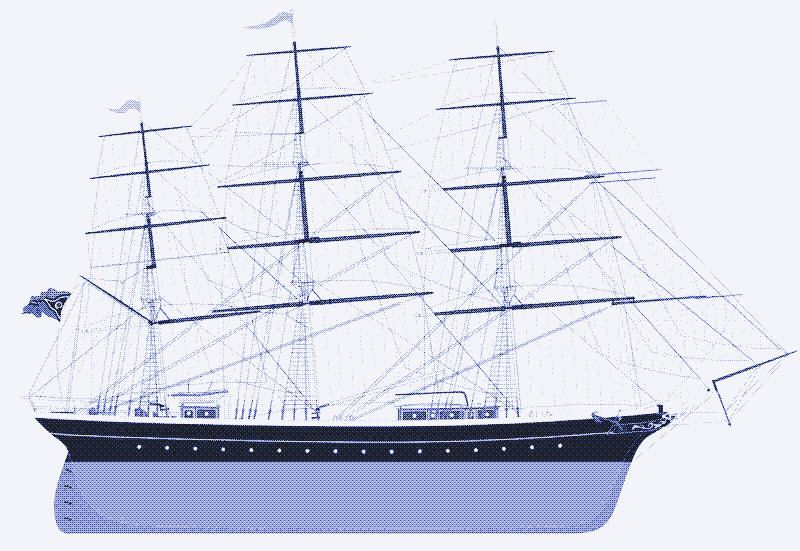
The 46 metre long Ceiba is powered by 580 m2 of sails and carries 250 tonnes of cargo. The 60 metre long EcoClipper500 is powered by almost 1,000 m2 of sails and takes 500 tonnes of cargo. For comparison, the Tres Hombres is not that much shorter at 32 metres, but she takes only 40 tonnes of cargo – twelve times less than the EcoClipper500. A larger ship is also faster and saves labour. The Tres Hombres requires a crew of seven, while the EcoClipper500 only has a slightly larger crew of twelve.
Life cycle analysis of a sailing ship
Although the EcoClipper500 is still in the design phase, she will be the focus of this article. This is because the company conducted a life cycle analysis of the ship prior to building it. 4 As far as I know, this is the first life cycle analysis of a sailing ship ever made. The study reveals that it takes around 1,200 tonnes of carbon to build the ship.
Half of those emissions are generated during steel production, and roughly one third is generated by steel working processes and other shipyard activities. Solvent-based paints as well as electric and electronic systems each account for roughly 5% of emissions. The emissions produced during the manufacturing of the sails are not included because there are no scientific data available, but a quick back-of-the-envelope calculation (for sails based on aramid fibres) signals that their contribution to the total carbon footprint is very small. 5
The EcoClipper500 has a carbon footprint of 2 grammes of CO2 per tonne-kilometre, which is five times less than the carbon footprint of a container ship.
If these 1,200 tonnes of emissions are spread out over an estimated lifetime of 50 years, then the EcoClipper500 would have a carbon footprint of about 2 grammes of CO2 per tonne-kilometre of cargo, concludes researcher Andrew Simons, who made the life cycle analysis for the ship. This is roughly five times less than the carbon footprint of a container ship (10 grammes CO2/tonne-km) and three times less than the carbon footprint of a bulk-carrier (6 grammes CO2/tonne-km). 6
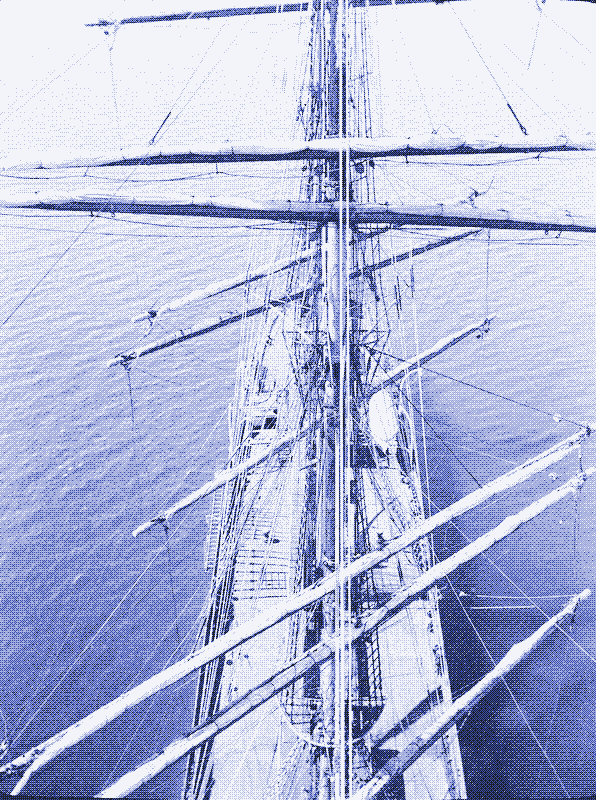
Transporting one ton of cargo over a distance of 8,000 km (roughly the distance between the Caribbean and the Netherlands) would thus produce 16 kg of carbon with the EcoClipper500, compared to 80 kg on a container ship and 48 kg on a bulk carrier. The proportions are similar for other environmental factors, such as ozone depletion, ecotoxicity, air pollution, and so on.
Although the sailing ship boasts a convincing advantage, it may not be as big as you might have expected. First, as Simons explains, there’s scale. A container ship or bulk carrier enjoys the same benefits over the EcoClipper500 as the EcoClipper500 enjoys over the Tres Hombres. It can take a lot more cargo – on average 50,000 tonnes instead of 500 tonnes – and it needs only a slightly larger crew of 20-25 people. 7
Second, fossil fuel powered ships are faster than sailing ships, meaning that fewer ships are needed to transport a given amount of cargo over a given period of time. The original ship on which the EcoClipper500 is based, sailed between the Netherlands and Indonesia in 65 to 78 days, while a container ship does it in about half the time (taking the short cut through the Suez canal).
Building a fleet of sailing ships
There’s two ways to further lower the carbon emissions of sailing ships in comparison to container ships and bulk carriers. One is to build ships from wood instead of steel, such as the Ceiba. If the harvested trees are allowed to grow back (which the makers of the Ceiba have promised), such a ship may even be considered a carbon sink.
However, there’s a good reason why the EcoClipper500 will be made from steel: the company’s aim is to build not just one ship, but a fleet of them. Jorne Langelaan: “There are few shipyards who can deliver wooden ships nowadays. Steel makes it easier to build a fleet in a shorter period.”
A possible compromise would be a composite construction, in which a steel skeleton is clad with timber keel, planks, and deck. Andrew Simons: “This would reduce the carbon footprint of construction by half. It could also be feasible to make superstructures and some of the mast sections and spars from timber instead of steel.”
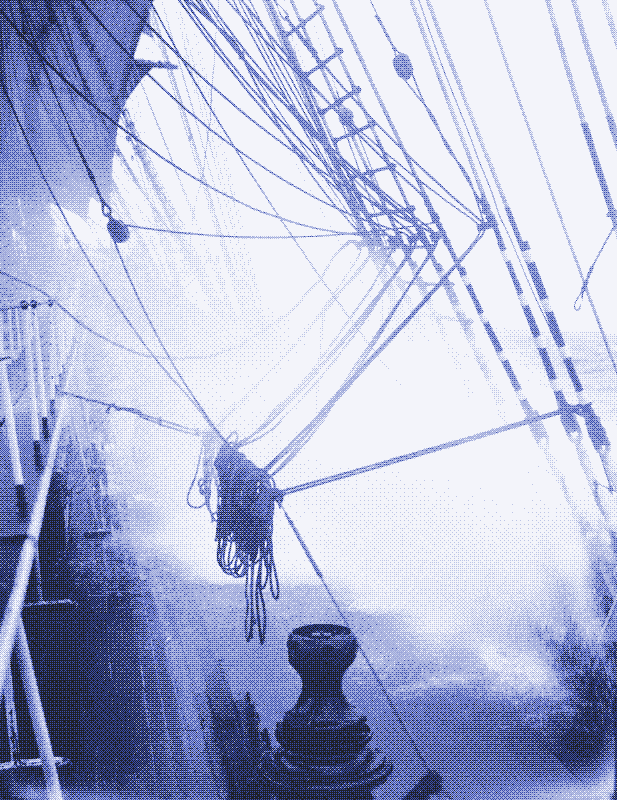
Towards the future, another possibility to further decrease a sailings ship’s emissions per tonne-km is to build it even larger. While the EcoClipper500 has much more cargo capacity than the cargo sailing ships now in operation, she is far from the largest sailing ship ever built.
Historical ships such as the Great Republic (5,000 tonnes), the Parma (5,300 tonnes), the France II (7,300 tonnes), and the Preussen (7,800 tonnes), were more than 100 metres long and could take more than ten times the freight capacity of the EcoClipper500. Langelaan already dreams of a EcoClipper3000.
Passengers
Most cargo sailing ships travelling across the oceans today can also take some passengers. Fully loaded with cargo, the EcoClipper500 takes 12 crew members, 12 passengers, and 8 trainees (passengers who learn how to sail). If the upper hold deck is not used for cargo, another 28 trainees can join, so that the ship can take up to 60 people on board (with a smaller cargo volume: 480 m3 instead of 880 m3).
The carbon footprint for passengers amounts to 10 g per passenger-km, compared to roughly 100 g per passenger-km on an airplane.
Consequently, and since ocean liners have disappeared, the EcoClipper500 also becomes an alternative to the airplane. According to the results of the life cycle analysis, the carbon footprint for passengers on the EcoClipper500 amounts to 10 grammes per passenger-kilometre, compared to roughly 100 grammes per passenger-kilometre on an airplane. Transporting one passenger thus produces as much carbon emissions as transporting 1 tonne of freight.
Engine or not?
Importantly, the life cycle analysis of the EcoClipper500 assumes that there is no diesel engine on-board. On a sailing ship, a diesel engine can serve two purposes, which can be combined. First, it allows to propel the ship when there is no wind or when sails cannot be used, for example when leaving or entering a harbour. Second, combined with a generator, a diesel engine can produce electricity for daily life on board of the ship.
For most of history, energy use on-board of a sailing ship was not too problematic. There was firewood for cooking and heating, and there were candles and oil lamps for lighting. There were no refrigerators for food storage, no showers or laundry machines for washing and cleaning, no electronic instruments for navigation and communication, no electric pumps in case of leaks or fire.
However, we now have higher standards in terms of safety, health, hygiene, thermal comfort, and convenience. The problem is that these higher standards are difficult to achieve when the ship does not have an engine that runs on fossil fuels. Modern heating systems, cooking devices, hot water boilers, refrigerators, freezers, lighting, safety equipment, and electronic instruments all need energy to work.
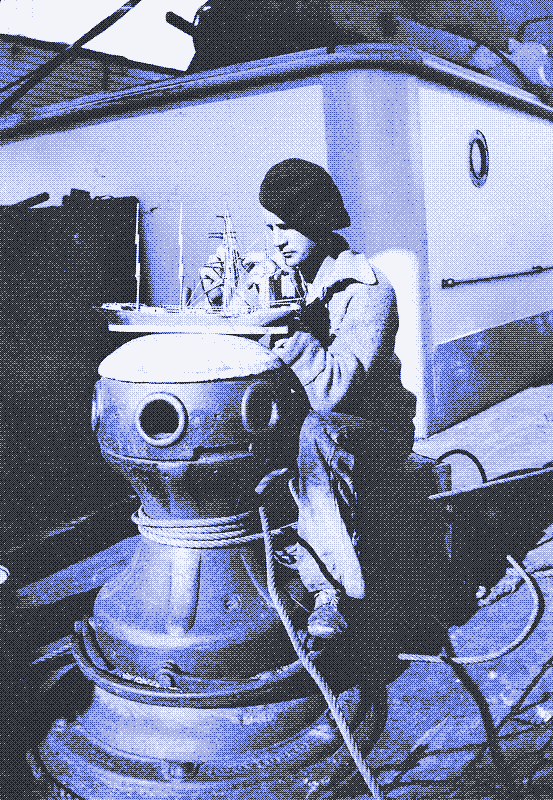
Modern sailing ships often use a diesel engine to provide that energy (and to propel the ship if necessary). An example is the Avontuur from Timbercoast, who has an engine of 300 HP, a 20 kW generator, and a fuel tank of 2,330 litres. Large sail training vessels and cruising ships have several engines and generators on-board. For example, the 48m long Brig Morningster has a 450 HP engine and three generators with a total capacity of 100 kW, while the 56m long Bark Europa has two 365 HP engines with three generators – and burns hundreds of litres of oil per day.
Depending on the lifestyle of the people on board, the emissions per passenger-km may rise to, or surpass, the levels of those of an airplane.
Obviously, the emissions and other pollutants of these engines need to be taken into account when the environmental footprint of a sail trip is calculated. Depending on the lifestyle of the people on board, the emissions per passenger-km may rise to, or surpass, the levels of those of an airplane. To a lesser extent, electricity use on-board also increases the emissions of cargo transportation.
Energy use on board a sailing ship
The EcoClipper500 has no diesel engine on board, which is a second reason to focus on this ship. Obviously, a sailing ship without an engine cannot proceed her voyage when there’s no wind. This is easily solved in the old-fashioned way: the EcoClipper500 stays where she is until the wind returns. A ship without an engine also needs tug boats – which usually burn fossil fuels – to get in and out of ports. For the EcoClipper500, these tug services account for 0.3 g/tkm of the total carbon footprint of 2 g/tkm.
Without a diesel engine, the ship also needs to generate all energy for use on board from local energy sources, and this is the hard part. Renewable energy is intermittent and has low power density compared to fossil fuels, meaning that more space is needed to generate a given amount of power – which is more problematic at sea than it is on land.
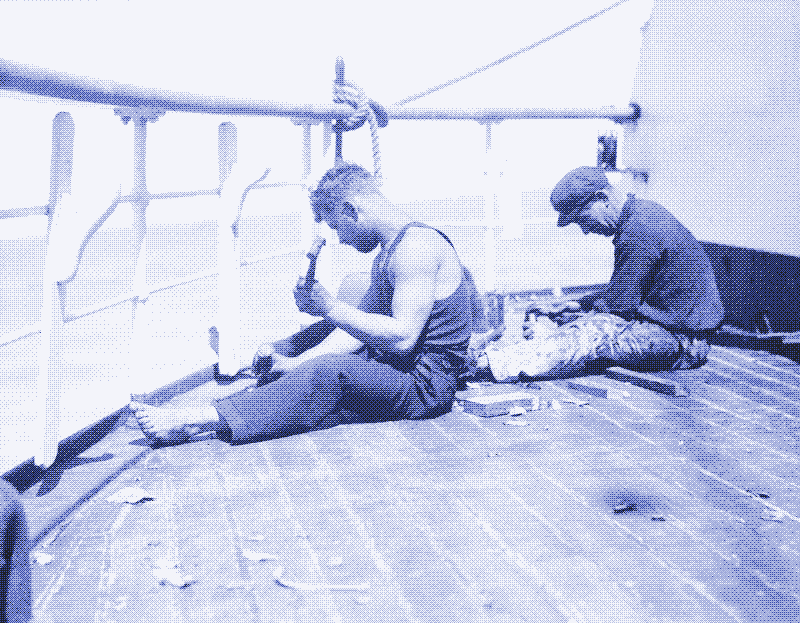
To make the EcoClipper500 self-sufficient in terms of energy use, a first design decision was to shift energy use away from electricity whenever possible. This is especially important for high temperature heat, which cannot be supplied by electric heat pumps. The ship will have a pellet-stove on board to provide space heating, as well as a biodigester – never before used on a ship – to convert human and kitchen waste into gas for cooking. Thermal insulation of the ship is another priority.
Nevertheless, even with pellet-stove and biodigester (which themselves require electricity to operate), and with thermal insulation, energy demand on the ship can be as high as 50 kilowatt-hours of electricity per day (2 kW average power use). This concerns a “worst-case normal operation” scenario, when the ship is sailing in cold weather with 60 people on board. Power use will be lower in warmer weather and/or when less people are taken. During an emergency, the power requirements can amount to 8 kW, while more than 24 kWh of energy can be needed in just three hours.
Hydrogenerators
How to produce this power? Solar panels and wind turbines are only a small part of the solution. Producing 50 kWh of energy per day would require at least 100 square metres of solar panels, for which there is little space on a 60 m long sailing ship. Vulnerability and shading by the sails make for further problems. Wind turbines can be attached in the rigging, but their power output is also limited. The low potential of solar and wind power are demonstrated by the earlier mentioned sailing ship Avontuur. She has a 20 kW generator, powered by the diesel engine, but only 2.1 kW of solar panels and 0.8 kW of wind turbines.
The hydrogenerator is the only renewable power source that can provide a large sailing ship with enough energy for the use of modern technology on board.
The hydrogenerator is the only renewable power source that can provide a large sailing ship with enough energy for the use of modern technology on board. Hydrogenerators are attached underneath the hull and work in the opposite way as a ship’s propeller. Instead of the propeller powering the ship, the ship powers the propeller, which turns a generator that produces electricity. In spite of its name and appearance, the hydrogenerator is actually a form of wind energy: the sails power the propellers. Obviously, this only works when the ship is sailing fast enough.
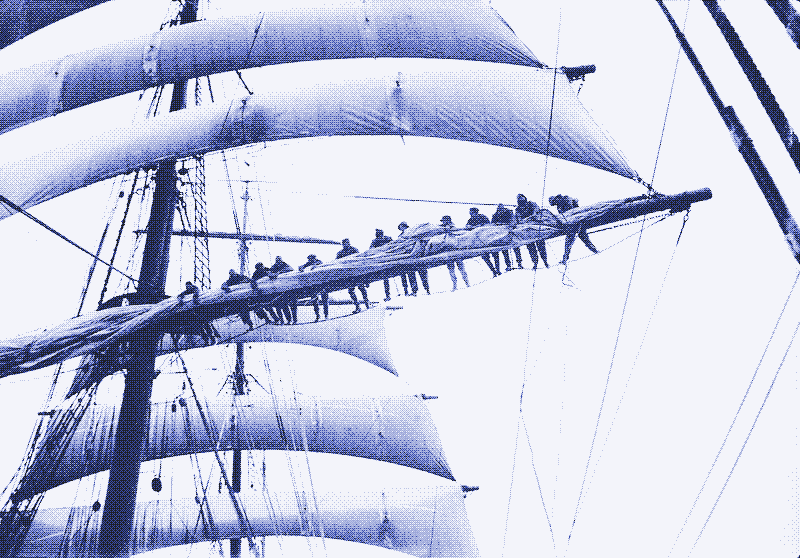
The EcoClipper500 will be equipped with two large hydrogenerators, for which Simons calculated the power output at different speeds, taking into account the fact that the extra drag they produce slows down the ship somewhat. He concludes that the EcoClipper500 needs to sail at a speed of at least 7.5 knots to generate enough electricity. At that speed, the hydrogenerators produce an estimated 2,000 watts of power, which converts to roughly 50 kWh of electricity per day (24 hours of sailing).
At a lower speed of 4.75 knots, the generators produce 350 watts, which comes down to 8.4 kWh of energy over a period of 24 hours – only 1/6th of the maximum required energy. On the other hand, at higher speeds, the hydrogenerators produce more energy than necessary. At a speed of almost 10 knots they provide 120 kWh/day, at a speed of 12 knots this becomes 182 kWh/day – 3.5 times more than needed.
Saltwater batteries
According to her hull speed, the EcoClipper500 will be able to sail a little over 16 knots at absolute top speed – this is double the minimum speed required to generate enough power. Achieving this speed will be rare, because it needs calm seas and strong winds from the right direction. Nevertheless, in good wind conditions, the ship easily sails fast enough to produce all electricity for use on board.
Good wind conditions can last for days, especially on the oceans, where winds are more powerful and predictable than on land. However, they are not guaranteed, and the ship will also sail at lower speeds, or find herself in becalmed conditions – when hydrogenerators are as useless as solar panels in the middle of the night.
Because she has no engine, the EcoClipper500 faces a double problem when there’s no wind: she cannot continue her voyage, and she has no energy to maintain life on board.
Because she has no engine, the EcoClipper500 faces a double problem when there’s no wind: she cannot continue her voyage, and she has no energy to maintain life on board. The first problem is easily solved but the second is not. Life on board goes on, and so there is a continued need for power. To provide this, the ship needs energy storage.
To cover the needs for three days drifting in cold weather, an energy storage of 150 kWh would be required, not taking into account charge and discharge losses. Five or seven days of energy use on-board would require 250 to 350 kWh of storage. For emergency use, another 25 kWh of energy storage is needed.

Not having an engine, generator and fuel tank saves space on board, but this advantage can be quickly lost again when one starts to add batteries for the hydrogenerators. Lithium-ion batteries are very compact, but they cannot be considered sustainable and bring safety risks. That’s why Jorne Langelaan and Andrew Simons see more potential in – very aptly – saltwater batteries, which are non-flammable, non-toxic, easy to recycle, have wide temperature-tolerance, and can last for more than 15 years. Like the biodigester, they have never been used on a sailing ship before.
Unlike lithium-ion batteries, saltwater batteries are large and heavy. At 60 kg per kWh of storage capacity, a 150 kWh battery storage would add a weight of 9 tonnes, while a 350 kWh storage capacity would add 21 tonnes. Still, this compares favourably to the total cargo capacity (500 tonnes), and the batteries can serve as ballast if they are placed in the lower part of the ship’s hull. The space requirements are not too problematic, either. Even a 350 kWh energy storage only requires 14 to 29m3 of space, which is small compared to the 880m3 of cargo volume.
The emissions that are produced by the manufacturing of the hydrogenerators, biodigester, and batteries are not included in the life cycle analysis of the ship, because there are no data available. However, these emissions must be relatively small. Hydrogenerators have much higher power density than wind turbines, and thus a relatively low embodied energy. A quick back-of-the-envelope calculation learns that the carbon footprint of 350 kWh saltwater batteries is around 70 tonnes of CO2. 8
Human Power
There’s another renewable power source and energy storage on board of the EcoClipper, and that’s the humans themselves. Like the pellet stove and the biodigester, the use of human power could reduce the need for electricity. Nowadays, cargo ships and most large sailing ships have electric or hydraulic winches, pumps, and steering gear, saving manual labour at the expense of higher energy use. In contrast, EcoClipper sticks to manual handling of the ship as much as possible.
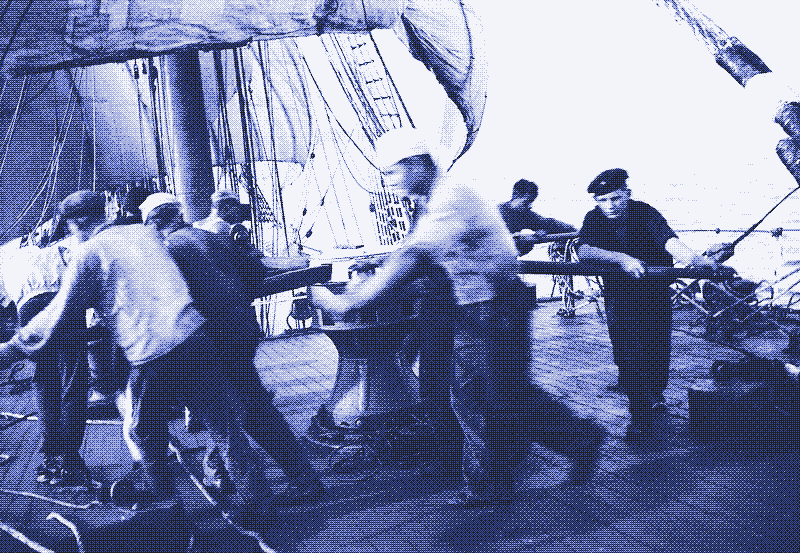
Simons and Langelaan are also considering the addition of a few rowing machines, coupled to generators, to produce emergency power. Two rowing machines could provide roughly 400 watts of power. If they are operated around the clock in shifts, they could supply the ship with an extra 9.6 kWh of energy per day (ignoring energy losses) – one fifth of the total maximum electricity use.
In fact, as I tell Simons and Langelaan ten rowing machines operated continually in shifts would provide as much power as the hydrogenerators at a speed of 7.5 knots. If there are 60 people on board, and everybody would generate power for less than one hour per day, no hydrogenerators and batteries would be needed at all. “A very interesting thought”, answers Simons, “but what impression would we be painted with?”
Hot Showers?
Even with a biodigester, hydrogenerators, batteries, and rowing machines, the passengers and crew on board the EcoClipper500 would be far short of luxurious, and perhaps too short of comfortable for some. For example, if 60 people on board the ship would take a daily hot shower – which requires on average 2.1 kilowatt-hours of energy and 76.5 litres of water on land – total electricity use per day would be 126 kWh, more than double the energy the ship produces at a speed of 7.5 knots.
The ship could supply this energy at a higher sailing speed, but there would also be a need for 4,590 liters of water per day, a quantity that could only be produced from seawater – a process that requires a lot of energy. Even a crew of 12 taking a daily hot shower would require 25.2 kWh of energy per day, half of what the hydrogenerators produce at a sailing speed of 7.5 knots. The Bark Europa is the only sailing ship mentioned in this article that has hot showers in every (shared) cabin, but it is also the ship with the biggest generators and the highest fuel use.
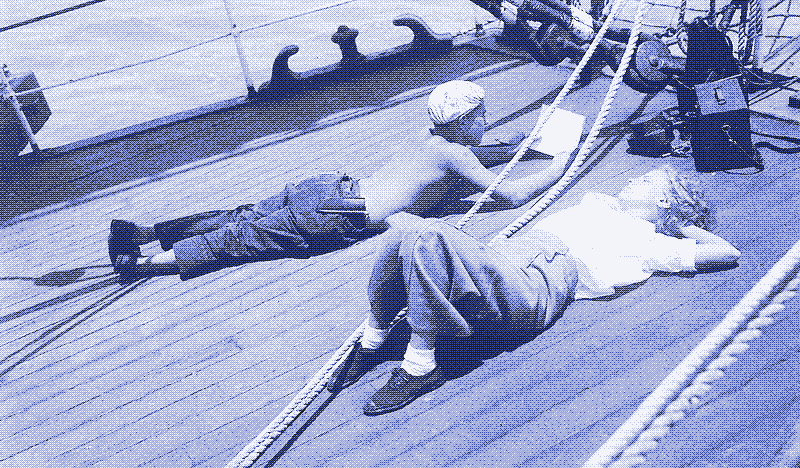
Andrew Simons: “On the EcoClipper500 there needs to be a manageable compromise between energy use and comfort. Energy use on board will have to be actively managed. Resources are finite, just like for the planet. In many ways the ship is a microcosm of challenges that the wider world has to face and find solutions to.”
Jorne Langelaan: “At sea you are in a different world. It doesn’t matter anymore if you can take a daily shower or not. What matters are the people, the movements of the ship, and the vast wilderness of ocean around you”.
Measuring the right things
This article has compared the EcoClipper500 sailing ship with the average container ship, bulk carrier, and airplane in terms of emissions per tonne- or passenger-kilometer. However, these values are abstractions that obscure much more important information: the total emissions that are produced by all passengers and all cargo, over all kilometres.
The international ocean freight trade increased from 4 billion tonnes of cargo in 1990 to 11.2 billion tonnes in 2019, resulting in more than 1 billion tonnes of emissions. International air passenger numbers grew from 1 billion in 1990 to 4.5 billion in 2019, resulting in 915 million tonnes of emissions. Consequently, lowering the emissions per tonne- and passenger-kilometre is neither a necessity nor a guarantee for a reduction in emissions.
If we cut international cargo traffic more than fivefold, and passenger traffic more than tenfold, then the emissions of all container ships and airplanes would be lower than the emissions of all sailing ships carrying 11.2 billion tonnes of cargo and 4.5 billion of passengers. Vice versa, if we switch to sailing ships, but keep on transporting more and more cargo and passengers across the planet, we will eventually produce just as much in emissions as we do today with fossil fuel powered transportation.
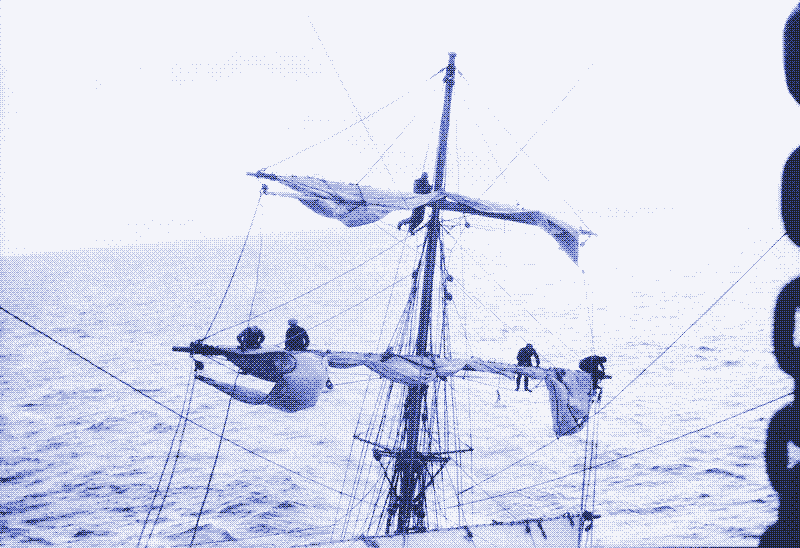
Of course, none of this would ever happen. The amount of cargo that was traded across the oceans in 2019 equals the freight capacity of 22.4 million EcoClippers. Assuming the EcoClipper500 can make 2-3 trips per year, we would need to build and operate at least 7.5 million ships, with a total crew of at least 90 million people. Those ships could only take 0.5 billion passengers (12 passengers and 8 trainees per ship), so we would need millions of ships and crew members more to replace international air traffic.
We should not be fooled by abstract relative measurements, which only serve to keep the focus on growth and efficiency.
All of this is technically possible, and as we have seen, it would produce less in emissions than the present alternatives. However, it’s more likely that a switch to sailing ships is accompanied by a decrease in cargo and passenger traffic, and this has everything to do with scale and speed. A lot of freight and passengers would not be travelling if it were not for the high speeds and low costs of today’s airplanes and container ships.
It would make little sense to transport iPhones parts, Amazon wares, sweatshop clothes, or citytrippers with sailing ships. A sailing ship is more than a technical means of transportation: it implies another view on consumption, production, time, space, leisure, and travel. For example, a lot of freight now travels in different directions for each next processing stage before it is delivered as a final product. In contrast, all sail cargo companies mentioned in this article only take cargo that cannot be produced locally, and which is one trip from producer to consumer. 9
This also means that even if sailing ships have diesel engines on board, they would still bring a significant decrease in the total emissions for freight and passenger traffic, simply because they would reduce the absolute number of passengers, cargo, and kilometers. We should not be fooled by abstract relative measurements, which only serve to keep the focus on growth and efficiency.
More about the EcoClipper500. Most images: Alan Villiers collection.
Reactions
To make a comment, please send an e-mail to solar (at) lowtechmagazine (dot) com. Your e-mail address is not used for other purposes, and will be deleted after the comment is published. If you don’t want your real name to be published, sign the e-mail with the name you want to appear.
Reactions
Bruce Weaver
Worth noting the work of John Todd
In his book healing earth. Great sail ship ideas!
John Mawhorter
Really like these two quotes:
Andrew Simons: “On the EcoClipper500 there needs to be a manageable compromise between energy use and comfort. Energy use on board will have to be actively managed. Resources are finite, just like for the planet. In many ways the ship is a microcosm of challenges that the wider world has to face and find solutions to.”
Jorne Langelaan: “At sea you are in a different world. It doesn’t matter anymore if you can take a daily shower or not. What matters are the people, the movements of the ship, and the vast wilderness of ocean around you”.
It roughly encapsulates a lot of what I find valuable about this site… thinking in detail about compromises that must be made, rather than assuming that in the future we must have the same levels of comfort when they are unsustainable.
As you note at the end, the speed/volume of a global sail-cargo economy implies the heavy degrowth to a sort of hybrid late 19th-early 20th c. economy style that is probably necessary to reduce emissions enough for civilization/our species to survive.
Thinking carefully about what technologies are worth preserving/reviving like this is very hard work, thanks for all you do!
Shane
Any thoughts on incorporating higher altitude kite sails into modern designs?
TonyH
Excellent article. A key driver for transportation system economics is the number of passenger km or tonne-km that can be delivered per year. This will have a strong effect on unit freight or ticket carriage cost because capital costs must be amortised against revenue. A slower speed is therefore a problem and you are relying upon the money saved in fuel exceeding the higher marginal capital cost and of course, the cost of consumables like food for passengers and crew. For this reason, I think sailboats will be more applicable to freight than passenger transport. The sails themselves will make container transport loading and unloading more difficult.
I would be interested to see an analysis of the potential for hydraulic capsule transportation. This would involve transporting goods at low speed contained within capsules floating within a pipe. The capsules could either be powered individually, or carried along in a moving stream of water, which could be pumped using wind powered pumps. Capsule pipelines could even be laid under the sea, in the way the old communications cables used to be. On land, there would seem to be no reason why goods cannot be transported over entire continents using wind powered capsule pipelines, perhaps 2m in diameter.
Drew Pearce
Great article. It’s so important not to let promises of innovation obscure the need for relatively large curtailments of demand.
It’s worth noting that 30-40% of international shipping demand (in t.km) comes from moving fossil fuels around. So a successful transition of the global economy away from the use of fossil fuels would likely to lead a fairly large reduction in demand itself. Although that would of course depend on whether any replacements also required significant shipping.
Nancy Sutton
Thanks a million - your work has inspired me for a long time :)
John Somdecerff
Hello Kris,
Thank you for another great article. I sometimes dream of having my own sailing ship.
However, I may have found a mistake.
You wrote:
ten rowing machines operated continually in shifts would provide as much power as the hydrogenerators at a speed of 7.5 knots. If there are 60 people on board, and everybody would generate power for less than one hour per day, no hydrogenerators and batteries would be needed at all.
However, if I’m thinking about this correctly, if there are 60 people for ten machines, each machine gets 6 people.
24 hours/6 persons = 4 hours/person
In addition, perhaps it is because I’m old and mostly sit in front of a computer, but 100 Watts is about all I can put out continuously.
So it seems that every effort must be made to minimize the use of electricity.
Thank you again for another great article,
John Somdecerff
PS I also love your articles about your solar powered web site. On my “to do” list is to post a comment about models of energy efficient cable modems. I’ve been meaning to upgrade my home service, but somehow I’m always busy with other things….
Jules Baw
Hi, I have followed Low Tech Magazine closely for many year now, its one of my favourite publications and also bought the book!
I am trained in traditional boat carpentry in Sweden, unfortunately there are not so may wooden boats around, so I mostly work with traditional building renovation techniques.
I have been thinking about various methods of propulsion/energy and wind power is the obvious no 1 propulsion method, however as a secondary power/heat source and one of the things I have been wondering about is Woodgas, or more specifically Pyrolysis, or to put it simple. . . making Biochar during the journey.
This would provide a heat source and some of the heat energy could be converted to electricity, though I have no idea how efficient that system would be. It would require large amounts of wood fuel, which may not always be readily available and is taking up cargo space, however upon arriving on destination the ship would have a cargo of Biochar thst does have a value.
Could the kinetic movement of the ship moving up and down somehow be converted into electrical energy? Kind of like those flashlights that share up when they are shaken?
Just some thoughts, that may be interesting to consider.
Thank you for wiring such thorough engaging and interesting articles!
Jules Baw
Jose Amador Silva
Perhaps I am thinking of this technology wrong, but, it occurs to me that all that steel, technology, labor and innovation would be better served building a tunnel and connecting Alaska and Asia.
Then passenger rail, cargo rail, and liquid fuels,.nat. gas, alcohol fuel, etc could be sent across it when needed. The rails could be run on electricity and generated from multiple sources.
I love sailing ships and they do have a place in our world and will continue to have a place, I just don’t think we’ll somehow rebuild the sailing age again unless civilization degrades, in which case we won’t have nearly the same levels of cargo movement or travel.
Nope, rail or tunnels is the way to go, underground and a little more reliable. Other than that… local production from global information sources would be ideal.
James Campion
Interesting article Kris - although somewhat depressing, as it’s difficult to envision large numbers of people being willing to sacrifice the convenience of modern global shipping. There is a Swedish consortium looking into building a sail powered/assisted ship for transatlantic car cargo:
https://www.oceanbirdwallenius.com
https://www.businessinsider.com/wing-powered-cargo-ship-aims-reduce-emissions-oceanbird-swedish-sailing-2020-9?r=US&IR=T#oceanbird-gets-its-power-from-five-262-foot-wings-which-are-made-from-metal-and-composite-theyre-twice-the-height-of-the-sails-on-the-biggest-sailing-ships-today-wallenius-says-1
https://en.wikipedia.org/wiki/Oceanbird
They claim a 90% reduction in emissions, with a max cargo of 7000 cars and sailing time of 12 days. The ship itself is a 200m RORO design with 50 m high retractable sails. A lifetime analysis has been performed by two MSc students at SSPA (one of the partners):
https://odr.chalmers.se/handle/20.500.12380/301648
Laurent
hello Kris,
glad to see an end to end analysis on the carbon intensity needed to build and power a vessel.
i am curious to know if you have ever written / researched on the emission from the moment the boat docks until the good is delivered to the end customer (home or market or retail store)
in the shipping today, efficiency equals big size / large cargo. but delivering the cargo from remote commercial ports is very emission intensive
the sailing vessels you describe are small relative to large bulk / containerships, thus reducing the infrastructure need in the harbor, this is an opportunity to develop a pier to pier trade, smaller vessels, but acceding port cities, delivering goods in the middle of a city, to a large market.
thanks for reading!
best regards
laurent
Sacha Ferbus
https://reporterre.net/VIDEO-Le-voilier-cargo-qui-transporte-cafe-cacao-et-vin-sans-polluer
Nathan Moore
I believe this post is the equivalent of a real “crowd-pleaser” for us fans of Low Tech Magazine…
Nick Macedo
In regards to wooden ship building and its environmental impact, the use and consumption of wood does indeed impact local forest environments. With that said, over time, using wood (especially in those quantities) is technically a form of carbon capture assuming the deforestation would eventually regrow. A sapling consumes vastly more c02 over a period of time vs. A fully grown tree no?
Mario Stoltz
Ah, wonderful topic and - as has been pointed out above - also very nice to visualize the change we need as a world society overall if we seriously consider becoming reasonably sustainable.
One item I noticed in the article is that the entire EcoClipper 500 is pictured as static so that the energy / CO2 equivalents can be written off over 50 years. Unfortunately, that won’t be the case. The salt mist above oceans is quite corrosive and the constant motion wears many items quickly.
All sails and the many kilometers of running rigging - regardless how modern their material - must be considered as consumables, and will have to be replaced every few years even best case.
Any ship - regardless if made of steel or wood - consumes lots of paint just to maintain the conservation of the surfaces against the elements (as well as tar and hemp to maintain the watertightness of a wooden ship). This also will mean several hundred kilos of these items every year. Also the working time and effort necessary to apply these is not a minor item.
Note that compared to large steel ships, the decks and rigging of sailing ships are much lower to the water and therefore more exposed to corrosion.
All of that is not an argument against sailing ships - rather points out how unsustainable current sea transport is today.
Another difference between sea cargo transport “then” and now is that today, all sorts of goods are transported by sea, including huge volumes of basically worthless plastic trinkets. Back when sailing transport was the norm, only relatively dense, high-value cargo made up what was moved. Lower-value goods were only transported if no other cargo was available, or to fill ships on their way back if they were serving routes with asymmetric commercial conditions (i.e. between a higher-developed country and a place that was mostly an import target).
Richard Kirby
I was lucky enough to do a round the world yacht race 20 odd years ago. We allowed ourselves one shower every 8 days (roughly when it was our turn to be on mother watch).
OTOH we had a massive dome on the back with a satellite dish that we could use for internet access (primarily access to weather information). So we needed to run the generator for several hours each day to keep the batteries topped up.
The hot water for the shower came from either the generator or running the engine (in neutral since we obviously were a sailing race). We had a desalination plant onboard too which needed the generator to run. In theory though our fresh water tanks were large enough to last in an emergency for most of a race leg, and under the race rules we were required to keep at least 2 of the 4 tanks fully topped up, and recommended to keep the other 2 mostly full.
The actual sailing bit was all manual, including hanking on sails, hoisting, and using winches.
Pr. Théodose
As a slight aside, over 100 wooden steamships were built for the U.S. Emergency Fleet at the end of WW1 but didn’t see much action during or after the conflict.
https://www.youtube.com/watch?v=rzoxCD-dolY
https://sanctuaries.noaa.gov/mallows-potomac/education/shipwrecks.html
They weren’t equipped with sails but could still constitute an useful template for a modern wooden cargo freighter.
Steven Woods
Dr. De Decker,
On 11 May 2021, you published an excellent article on building and
designing a carbon neutral sailing vessel, which brought up a number
of good points about the carbon impact of sailing vessels, and the
necessity to adapt our habits and lifeways to a restricted
transportation capacity in future if we are to realize a viable
climate transition.
While I enjoyed the article, it did fail to touch on two things:
First, that we are now in a situation where we must carefully choose
what impacts we inflict on the world as we make a transition away from
fossil fuels, with Sail Freight being one of the better options for
the majority of trade in this case. Second, that trade can only be
reduced within certain boundaries. The second point is the most
important, and what I would like to address here, as I recently
completed my Master’s thesis on the subject.
The major reason shipping, both international, coastal, and inland,
cannot be reduced beyond a critical threshold is that cities must
receive around 2.5 kilograms of food per capita daily to stay alive. A
more realistic figure over the long term would be about 3.4 kilograms
per capita daily. Of course, since victory gardens, urban farms, and
other plans to grow food in cities simply cannot create the capacity
needed to feed a city within its own boundaries, food must be shipped
in from elsewhere. Even relatively large areas examined as a system,
such as New England, with a greatly expanded agricultural base, will
still have to import around 50% of their food in 2060, for 15 million
people. This requires shipping capacity, because food on a dock in
Australia simply cannot be eaten by people sitting at a table in
Providence, Rhode Island.
With this in mind, a fleet which models roughly around the foodshed of
New York City’s Metro Area, with a population of 20,000,000 people,
requires some 9,589 ships of 111.5 tons Cargo Deadweight Tonnage
(CDWT) and a labor pool of some 62,330 sailors. The coffee fleet of
New York, if using Belem Brazil as the coffee’s point of origin, adds
another 84 ships and 546 sailors. These ships are small vessels,
roughly the size and capacity of Avontuur, and as you observed in your
article, the larger the ship, the less voyages required for the same
level of supply. Thus, what becomes truly important for each major
portion of the supply system is Fleet Tonnage, which for New York is
total of 1,066,145 at the 2.5 kilogram per capita level of supply. At
3.4 kilograms, the fleet tonnage in this model increases to 1,446,855
tons. New England, with a population of 15 million, would need a fleet
capacity of 301,289 tons for external trade only, assuming 50% of the
region’s food is produced locally. The internal flows of food would
likely require a fleet of similar size along the region’s coastal and
inland waters to move food from rural to urban areas. These numbers
are absolute minimums, allowing for no crew rest or ship idle time
aside from lading and unlading, and the amount of supply is similarly
a near absolute minimum.
Sail Freight also helps with the ballance of available energy for
transporting food to places not accessible by water. By using the wind
to transport goods as close as possible to inland cities, and near
exclusively for transport to coastal cities, the demand for energy on
inland transportation systems such as rail and road is reduced
significantly. Due to the comparative lack of available energy from
biofuels, renewably generated electric power, and other sources for
powering trains and trucks, as well as the basic limitations of
electric trucks and trains, when compared to fossil fueled systems,
reducing the energy demands of inland transportation should be a top
priority at every level.
Another unstated advantage of windjammers is their suitability for a
highly democratic form of trade and ownership. Inexpensive wooden, and
even steel or fiberglass vessels converted from leisure use or built
to the purpose allow small groups, such as a coalition of farmers or a
food co-op to establish their own transportation networks free from
fossil fuels and most outside inputs. This allows the reduction of
middle-men taking farm cuts of food money, and increases the autonomy
of communities in decision making and economics, freeing them to some
degree from Mumford’s Megamachine and Megatechnics.
Sailing Vessels can be built both rapidly and with very little
capital. Additionally, they can be produced without the use of
Strategic Materials for either the current Petroleum economic system,
or those needed for the transition to renewable energy. Through their
lifetime they have very minor emissions compared to electric trucks,
container ships, bulker ships, and even trains. The comparative lack
of additional infrastructure which would be needed to adopt and
proliferate the use of such transportation capacity is also worth
considering, as small vessels will be especially well suited to
delivering directly to smaller ports, reducing the use of more energy
intensive land transportation for the final legs of the food journey.
Whie windjammers are generally a bit slower, they are still one of the
best options available to the world for ensuring we don’t have either
mass starvation in cities or an absurd overshot of any survivable
climate change thresholds.
While this level of food transportation is of course the floor of
trade capacity which cannot be reasonably reduced without significant
human suffering, a larger windjammer fleet should be encouraged. The
movement of Strategic Materials such as Lithium, Cobalt, Manganese,
Indium, Silica, Copper, and all the other metals and materials needed
to make a socially acceptable and Just energy transition will be
critical, and these materials are not distributed justly across the
world. Without a low-impact means of transporting these materials,
tools, equipment, and resources across the globe, many regions will
likely continue using fossil fuels to maintain a socially acceptable
level of energy use. While we may understand this is both stupid and
suicidal in the long term, most peole don’t seem to understand this
yet. Burning tens of thousands of tons of oil to move the tools of a
renewable and sustainable future to their points of use seems both
absurd and self-defeating; windjammers offer a means of doing so with
relative ease and reasonable environmental costs.
In short, when examined at scale, there are few technologies which can
both keep cities alive and move the necessary cargo for the energy
transition with such low emissions as sail freight. Further, the
advantages of a sail freight future for the democratization of trade,
energy, transportation, and the economy lend an additional set of
reasons for encouraging the proliferation of sailing vessels wherever
practical. Essentially, the design of the ship is immaterial, so long
as it sails and we change our outlook on trade to moving only hat
which is actually necessary.
I have attached my thesis for your review, if you are so inclined.
https://drive.google.com/file/d/19WDQ0H-FhoBsKJSv0a6bWZZKWXEaX-CI/view?usp=drivesdk
The
appendixes include a directory of current and planned sail freight
operations worldwide (pp 94), which may be helpful. Fleet requirements
for a variety of US cities and regions are included in the tables
throughout, and a rather limited eans of calculating bunker fuel use
avoided through sail freight is also provided, though I am in the
process of adapting this particular portion of the thesis to a wider
variety of vessel types as I expand the thesis into a book-length
study.
Thank you for your time and consideration. It should be noted I am a
big fan of your work, and used it extensively in researching and
writing my thesis. I look forward to more reading on your site, and,
of course, I’m always partial to anything sail-freight related.
Best,
Steven Woods
Mario Stolz
@Steven Woods,
thank you so much for sharing your master thesis with all of us, I just downloaded and very much look forward to reading it. While I must admit I struggle to imagine a world with sustainable sea transport on such a scale, I would certainly very much welcome it.
Best wishes.
Alistair Chaplin
Hi. Refering to the contribution of the sails and spars to the carbon emissions associated with a modern windship you may be interested in a paper we did looking to estimate the EROI of a modern windship that we presented at the Innovsail 2020 conference. This may be the envelope you lost…
www.bdi.fr/wp-content/uploads/2020/05/PAPERS-AT-INNOVSAIL-final.pdf&ved=2ahUKEwjumoGb8rnxAhXbilwKHbtqB_UQFjACegQIDhAC&usg=AOvVaw233g-gJ9p7B2xqogIqNRD6
Frederik Marain
My father (a sailor) used to say: “A sailing ship is the most expensive way to get around in the cheapest way.”
Israel Walker
@ Dr. De Decker
Excellent article. It’s an unpopular minority opinion to regard green technology as technology with advantages and drawbacks rather than magic.
Some random thoughts your article inspired:
It would seem that the energy use of the ship’s crew per capita would need to be compared to the energy use of the ship’s crew staying at home. The energy cost of human life must be paid no matter where the lives are.
It seems there is room for significant improvement regarding labor. One wonders at what point it is more effective in energy use to run the ship as a drone with basic autonomous and remote control, but board the ship with full crew for the first and last 1% of travel.
The numbers for steel surprise me, and I wonder if we were going to project a low fossil fuel technology base for steel, how they might change. For instance, recycled steel in Norway (where 95% of power is hydro) using sea algae or wood pulp charcoal rather than coal as the carbon base? In such a case steel becomes a carbon sink, like wood.
There is the further option of biorock/seacrete ships. Concrete ships are well known, and well studied. Biorock and concrete have approximately similar embedded energy. While concrete has high carbon emissions, biorock can be made from any source of electric power, including offshore electric.
For coastal trade, also might consider marine, below-the-surface trolley system using offshore wind power, and inductive transfer at the pantograph, with electric motors on the ships. Offshore wind power needs to be laced together with submarine cable anyway. As long as the cable was hung 25 m below the surface, Malaccamax ships (which have the deepest draft) could safely pass over it. The Asia/India/Suez/Europe trade route can and does stay within the green zone for offshore power. This is still wind power, albeit using late 19th century technology rather than late 18th.
Projecting further into the future, submarines are more efficient (in terms of watts/ton of cargo)than surface ships. Submarine gliders are the most efficient of all, needing to use energy only to change ballast, and gliding 20-35 m forward for every 1 m they sink or raise. In the small sizes already being built they have 1500 km range and 6 month operational lives on pure battery power. Concrete submarines are already tested technology and are ideal for deep water operations.
@ Mr. Steven Woods
To me, a technically minded person with terrible social skills, it seems that dismantling population centers down to a patchwork of six story cities approximately the size of Eixample is no less doable than any of the other changes we must make. It never crossed my mind that the >1M person city was sustainable due to logistical tail lengths.
Feri Setiawan
21st century sail ship must employ
Automatic navigation (ship outopilot) wind data from sea drones, buoys and satellites;
Stirling engine on parabolic solar concentrator for onboard power and backup propulsion;
Selective bulk cargo;
Selective route.
LazyReader
Nuclear marine propulsion is a viable technology for implementing long range carbon reduced shipping. Fukushima doesn’t reinforce it’s danger, it proves its safety. A 40 year old reactor was hit by a massive earthquake & tsunami much larger than design tolerance and survived remarkably well with minimal damage and killed NObody.
The NS Savannah had a near perfect safety record. Ran on a 74 MW reactor with steam plant making 24,000 hp. A smaller reactor and power plant would make a slower vessel, since comparison to wind the power plant, the ship with 8000 hp would yield 7 knots, but do so consecutively around the clock even in dead wind. No batteries.
BLMac
Ship hulls can be made from ferro concrete.
Examples of WW1 ships built like this are still afloat eg in the harbour of the Island of Scalpay in Scotland.
No need for corrosion protecting paints and approaching infinite hull life.
James Bromfield
A ball makes minimal drag on water, what if a large ball was constructed that had a platform inside for cargo but the exterior rotates with the water, cargo capacity with minimal drag? Then a flat top pyramid style frame goes over the ball with sails to provide the propulsion.
I guess im trying to say that the conventional hull is always creating resistance, doesnt a ball shape reduce the drag but still allow load to be carried?
Quinn
Kris,
I enjoy reading about low tech solutions to today’s problems. I am interested in novel approaches to shipping cargo.
But less than halfway into reading the article, a ship is referred to as “she”! And then, of course, that absurdity is repeated throughout the rest of the article.
What??? Are you seriously living in the 19th century?? Ships do not have a gender. Ships do not gestate young. They do not lactate. They are not biological beings. They ARE NOT “SHE”!
“She”, to refer to a ship, was ALWAYS done in a sexist way— a male commanded the ship, a male made the ship do his bidding. A male supposedly “cared for” his ship, the way he supposedly cared for “his” woman. There are all kinds of subtle and sexist connotations that men used in referring to their ships, back when women weren’t even allowed on them due to the unimaginable sexism inherent in the society.
Society has changed. Women are fully functioning assets contributing to their societies today. Women command ships today.
Let’s lay off the disgusting, sexist, antiquated language, eh?
In fact, you’d do yourself a service to quickly re-write the article before others also see it. How embarrassing for you.
Quinn
A woman, not a ship.
John Smith
Quinn: Your comment is a perfect example of the all-to-common absurd “Woke”/PC nonsense about words. You are obviously NOT a sailor and have had nothing to do with ships. I’m a man (a cis man for your information) and I’ve been sailing yachts all over the world for 60 years. There’s nothing sexist about me calling my yachts “she”; its only in your woke mind. If you spend months/years on a yacht it always becomes more than just an “it”. I refer to my yacht as a “she” as a term of endearment. All the women captains I’ve shared my sailing experiences with always referred to their yacht as a “she”. Lighten up!!!
Elijah
I don’t remember what they are called, but there are kite-based sails that have been invented to help save fuel for modern ships. It flies in a big figure 8 in front of the ship… and similar kite sails can also be used for power generators (as opposed to electric windmills).
Michael
Regarding comments on the use of “sexist” pronoun in the context of ships and projecting the confused reasoning that a human female must literally BE a ship, if any ship is referred to as “she”:
It’s funny when “woke” ideologues refer to the protection of “MOTHER EARTH” when it comes to environmental stewardship (
Bill
Hello I have not read the article or comments, but I wonder if there are enough large mature trees [tight growth rings with few knots] to contemplate the size of masts and wood needed for fleets of steel and timber ships let alone for wood only ships and does anyone even have the skills needed to make these incredible structures.
Tim Woodman
Hi Folks.
A good article about designing a new sailing ship but it doesn’t mention anything about crewing them. You have to train the top gallant men from a very early age, like 12 years old.
Older men cannot do this as they will fall off in even a mild storm, they will have to be fully trained from a young age. This is why the Royal Navy had boys training establishments and ships up until the mid 2th C, the last one was HMS Arethusa II which was retired in 1974.
Historically, impressed men were not suitable for top gallant work as they died rather quickly and as a consequence the ship would be lost as they could not furl or raise the top sails.
Top Gallant men were the creme de la creme of any ships crew.
Yours aye, Tim Woodman, ex HMS Ganges.